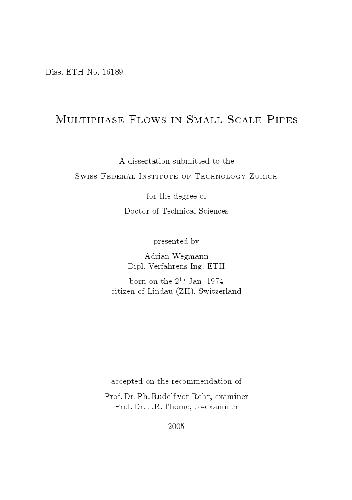Wegmann A.
Table of contents :
Vorwort……Page 5
Summary……Page 7
Table of Contents……Page 9
Nomenclature……Page 17
1 Introduction……Page 21
1.1.1 Transport Facilities……Page 22
1.1.2 Tubular Reactors……Page 23
1.2.1.1 Liquid-Gas Flows……Page 28
1.2.1.2 Liquid-Liquid Flows……Page 30
1.2.1.3 Liquid-Liquid-Gas Flows……Page 31
1.2.2 Pressure Drop……Page 33
1.2.2.1 Liquid-Gas Flows……Page 34
1.2.2.2 Liquid-Liquid Flows……Page 37
1.2.2.3 Liquid-Liquid-Gas Flows……Page 38
1.4 Structure of the Thesis……Page 40
2 Experimental Setup, Measurement Methods……Page 42
2.1 Description of the flow test facility……Page 43
2.2 Optical Devices……Page 46
2.2.1 The Problem of Light Distortion……Page 48
2.2.2 Multiple Distortion……Page 55
2.4 Measurement Accuracy……Page 60
2.5 Reproducibility of Measurements……Page 61
2.6 Limitations of the Experimental Setup……Page 64
3 Two-Phase Liquid-Gas Systems……Page 66
3.1.2 Transitions Between Flow Regimes……Page 67
3.1.3.1 Types of models……Page 70
3.1.3.2 Closure Relationships……Page 72
3.1.3.3 The Taitel Dukler Model……Page 74
3.1.3.4 The Weisman Model……Page 79
3.1.3.5 The Zhang Model……Page 81
3.1.3.6 The Petalas Model……Page 88
3.1.4.1 The Method of Lockhart and Martinelli……Page 91
3.1.4.2 The Method of Storek and Brauer……Page 94
3.2.1 Flow Pattern Maps……Page 96
3.2.1.1 Comparison to the Flow Map of Baker……Page 100
3.2.1.2 Comparison to the Flow Map of Mandhane……Page 105
3.2.1.3 Comparison of the Taitel Model with the Experimental Data……Page 110
3.2.1.4 Comparison of the Weisman Model with the Experimental Data……Page 114
3.2.1.5 Comparison of the Zhang Model with the Experimental Data……Page 115
3.2.1.6 Comparison of the Petalas Model with the Experimental Data……Page 116
3.2.1.7 Summary on Models Predicting Liquid-Gas Flows……Page 117
3.2.2.1 Experimental Results……Page 118
3.2.2.2 Comparison with Models……Page 119
4 Two-Phase Liquid-Liquid Systems……Page 122
4.1.1 Transitions Between Flow Regimes……Page 123
4.1.2 Flow Pattern Prediction Models……Page 126
4.1.2.1 The Brauner Model……Page 127
4.1.3.1 The Homogeneous Dispersed Model……Page 134
4.1.3.2 The Method of Brauner……Page 136
4.2.1 Observed Flow Patterns……Page 140
4.2.2 Flow Pattern Maps……Page 144
4.2.2.1 Comparison of the Brauner Model with the Experimental Data……Page 151
4.2.3 Pressure Drop……Page 153
4.2.3.1 Comparison with Models……Page 154
5 Three-Phase Liquid-Liquid-Gas Systems……Page 157
5.1.2 The Flow Pattern Prediction Model by Taitel……Page 158
5.1.3 The Pressure Drop Correlation by Millies……Page 161
5.2.1 Observed Flow Patterns……Page 164
5.2.2 Flow Pattern Maps……Page 166
5.2.3 Comparison with Literature Data……Page 171
5.2.3.1 Comparison with the Flow Map of Acikgoz et al…….Page 173
5.2.3.2 Comparison of the Brauner Model with the Experimental Data……Page 174
5.2.4 Pressure Drop……Page 175
5.2.5 Comparison with the Model of Millies……Page 176
6 Conclusions and Outlook……Page 179
6.1 Liquid-Gas Flows……Page 180
6.2 Liquid-Liquid Flows……Page 181
6.3 Liquid-Liquid-Gas Flows……Page 182
6.5 Application of -PIV……Page 184
A Pressure Drop Data: Additional Graphs……Page 188
B Flow Pattern Data: Additional Graphs……Page 192
C.1.1 Flow Patterns of Water-Air Flows in the 5.6 mm Pipe……Page 202
C.1.2 Flow Patterns of Paraffin-Air Flow in the 5.6 mm Pipe……Page 206
C.1.3 Flow Patterns of Water-Air Flow in the 7.0 mm Pipe……Page 209
C.1.4 Flow Patterns of Paraffin-Air Flow in the 7.0 mm Pipe……Page 213
C.1.5 Pressure Drop of Water-Air Flows in the 5.6 mm Pipe……Page 217
C.1.6 Pressure Drop of Paraffin-Air Flows in the 5.6 mm Pipe……Page 218
C.1.7 Pressure Drop of Water-Air Flows in the 7.0 mm Pipe……Page 219
C.1.8 Pressure Drop of Paraffin-Air Flows in the 7.0 mm Pipe……Page 221
C.2.1 Flow Patterns of Paraffin-Water Flow in the 5.6 mm Pipe……Page 223
C.2.2 Flow Patterns of Paraffin-Water Flow in the 7.0 mm Pipe……Page 230
C.2.3 Pressure Drop of Paraffin-Water Flows in the 5.6 mm Pipe……Page 234
C.2.4 Pressure Drop of Paraffin-Water Flows in the 7.0 mm Pipe……Page 238
C.3.1 Paraffin-Water-Air Flow in the 5.6 mm Pipe……Page 242
References……Page 249
Curriculum Vitae……Page 254

Reviews
There are no reviews yet.